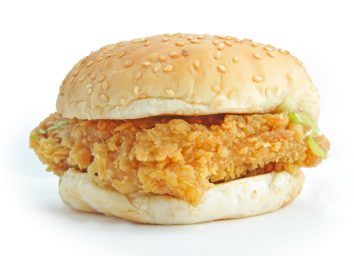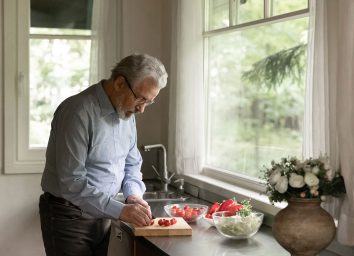Here’s Why There May Be Poop In Your Lunch
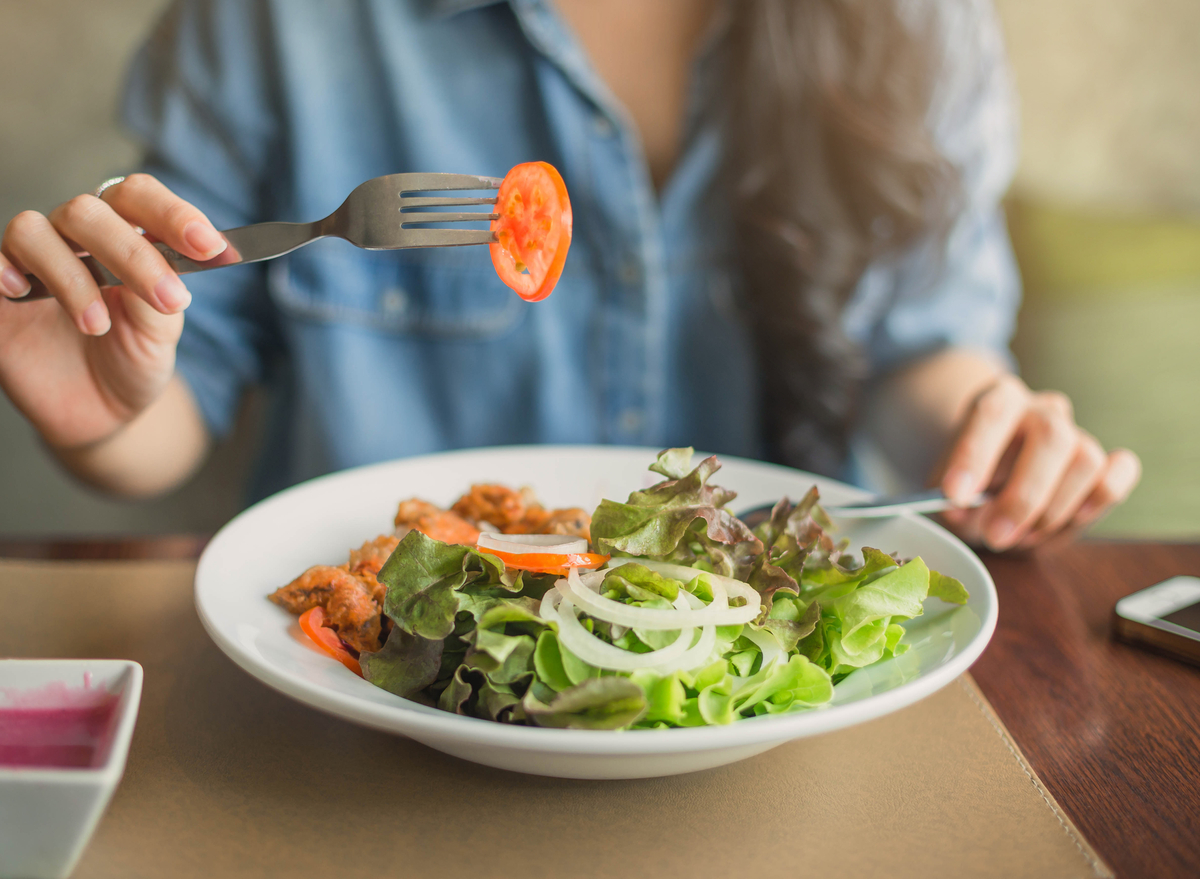
Imagine chopping up a delicious salad for lunch full of good-for-you leafy greens and crowned with raw veggies like tomatoes and shredded carrots. So healthy, right? You’re feeling good and patting yourself on the back about your food choices. But what if we told you your healthy lunch has the potential to contain actual animal feces which can cause foodborne illness? That salad is probably looking less appealing and more like a high-risk choice.
“The primary way you will get sick from your food today is from your salad, leafy greens, and any fruits and vegetables that you eat raw and uncooked,” said Scott Faber, Environmental Working Group’s senior vice president of government affairs. “The primary way pathogens get into these foods is through the irrigation water [used on farms] which is filled with animal feces.”
That’s right, animal feces. Poop. So what are the chances that your lunch contains poop particles?
First, the Centers for Disease Control and Prevention estimates that 1 in 6 Americans (roughly 48 million people) contract a foodborne illness each year. Foodborne illness (a.k.a. food poisoning) occurs because dangerous and sometimes deadly strains of bacteria such as E. coli, Listeria, Salmonella, and others lurk in certain foods. Of the estimated number of people who get sick each year, 128,000 are hospitalized while 3,000 people die. And those are just approximate numbers.
While you can get foodborne illnesses from contaminated animal protein like chicken and beef, eggs, milk, and cheese, raw produce is the culprit nearly 50% of the time. According to the CDC, leafy greens like romaine lettuce and spinach are often the highest offenders among raw veggies out there and are a major source of E. coli contamination. Seems like headlines have been rife with recalls on various batches of spinach or romaine over the past few years.
“It used to be you could wash your veggies three times and get [pathogens] off, but now it’s growing into the roots from the water below,” said Jaydee Hanson, policy director for the Center for Food Safety. Though extreme, he said he feels as though he should warn people to “cook their lettuce” before they eat it.
And don’t miss One in Four People Contaminate Their Food When Cooking With This Ingredient, New Study Shows.
The process of contamination
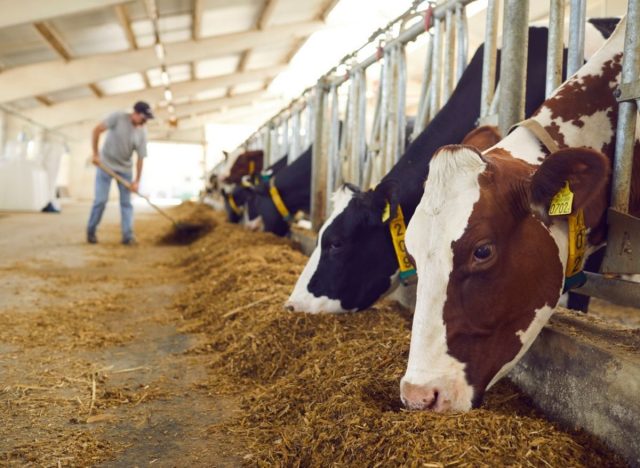
When you have a produce farm next to an animal farm (chickens, cows, pigs, etc.), there’s a lot more poop around, which raises the risk of contaminated irrigation water. And, if you’re thinking that farmers using manure to fertilize plants means poop on produce can’t be that big a deal, think again.
According to Brian Ronholm, director of food policy for Consumer Reports, who used to work for the Department of Agriculture under the Obama Administration, the process of composting manure involves applying heat, which kills a lot of the pathogens.
And thankfully, there are restrictions, such as raw manure cannot be used as fertilizer within 120 days of harvest. “The problem … is raw manure flows from nearby feedlots and either ends up directly on the field, or the pathogens end up in the ag [agricultural] water and get applied directly on the field.”
The poop loophole
More than a decade ago, Congress passed the Food Safety Moderation Act to help protect Americans from foodborne illnesses. The FDA has worked to implement all of the regulations stipulated by law. However, one area that hasn’t been fully addressed 11 years later is the safety of ag water used for produce. The agency proposed some standards in 2015, but many consumer and food safety advocates said they fell short.
“The FDA was supposed to set standards for how much poop can be in the irrigation water and sprayed on your lunch,” Faber said. “After coming under extraordinary pressure from farmers, now it’s completely left up to the farmers how much poop can go on your lunch.”
The testing issue
The problem has to do with testing. Findings published via a month-long investigation by Politico revealed that if a farmer uses a microbial test on a morning-water sample and it comes out clean, that doesn’t mean an evening or next-day sample of that same water will also be clean because agricultural water is constantly changing.
There are environmental factors to consider. Ronholm said birds, wild animals, wind, and more can also increase the levels of contaminated feces in the produce fields.
“We’re finding that the testing levels are not correlated to how safe the water is,” said Dr. James Kincheloe, food safety campaign manager for the Center for Science in the Public Interest (CSPI).
Ronholm said another issue is the FDA doesn’t have jurisdiction to inspect animal feeding operations and check for pathogens. He believes there is a need for legislation to give the FDA the power to do these inspections.
The FDA did propose a new set of guidelines for ag water in December 2021 under the Produce Safety Rule. According to an FDA spokesperson, the agency has since conducted two public meetings and several webinars to explain the proposal and solicit comments from stakeholders (the deadline for comments ended in April).
“We are committed to working diligently to consider the comments,” the spokesperson said. “The proposed rule is thorough and builds on scientific developments and lessons learned from recent produce outbreak investigations (particularly regarding issues stemming from adjacent and nearby lands). The agency believes that, if finalized, it will help bend the curve of foodborne illness and provide benefits for generations to come.”
Some feel the new guidelines are still too flexible. “Consumers don’t always have the best food safety practices in their kitchen. I go into this thinking that they don’t, so I want to make sure any food that enters their kitchen is safe,” Kincheloe said as to why he and others are fighting for strict guidelines. In his opinion, “the guidelines need to say, these are the standards that everyone should meet.”
How to protect yourself
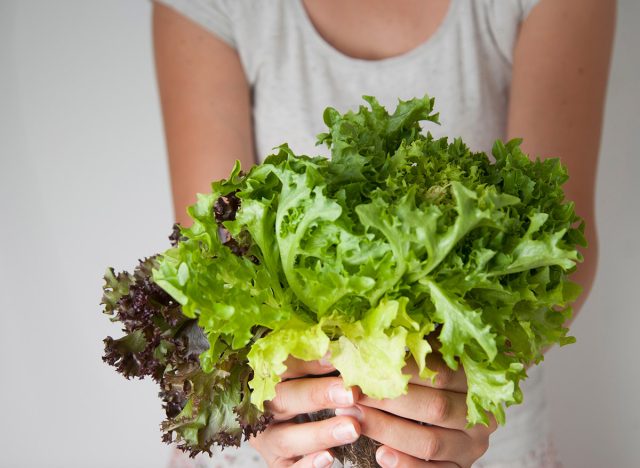
First, don’t panic. Eating leafy greens has tremendous health benefits. While there are some instances of foodborne illness stemming from contaminated produce, it’s by no means an epidemic.
Until more stringent guidelines are implemented, however, there are some things you can do to protect yourself.
- Practice safe food handling and preparation. The FDA suggests washing your hands with warm water and soap for at least 20 seconds before and after handling raw foods.
- Weigh the risks and identify the riskiest. Ronholm said romaine lettuce tends to be the riskiest of the leafy greens simply because its bumpy texture makes it easier for pathogens to cling to it. That doesn’t mean you should avoid romaine, just make sure you thoroughly wash it before eating it.
- Ask your local farmers. Danielle Melgar, PIRG’s food and agriculture advocate, said local farmers know if they are near animal farming operations and feedlots. So, if you’re at a farmer’s market, feel free to ask growers about their farming conditions and choose accordingly.
- Consider indoor growers. “In traditional agriculture, water is not typically tested before being used to irrigate crops, which means that it could contain contaminants, such as pesticides or animal manure, from outside sources and pose a threat to public health,” Bowery Farming General Counsel Christopher Livingston stated in a recently published report. “Indoor growers, like Bowery, typically use filtered municipal water and then further ensure cleanliness by regularly testing their irrigation water for contaminants and using reverse osmosis to further clean the water.”
- Grow your own food on a balcony or roof, in your backyard, or in a community garden. Melgar said just know that if you’re growing your own food, be aware of other contaminants like lead in the pipes of your building that deliver water to the garden hose. “It’s a balance,” she said.
- Wash leafy greens even when they’ve been “prewashed.” Brian referred to a Consumer Reports study in which they determined there was no difference in bacteria levels between whole head and triple-washed packaged romaine lettuce. According to the CDC, the “best way to wash leafy greens is by rinsing them under running water. Studies show that this step removes some of the germs and dirt on leafy greens and other vegetables and fruits. But no washing method can remove all germs.”

